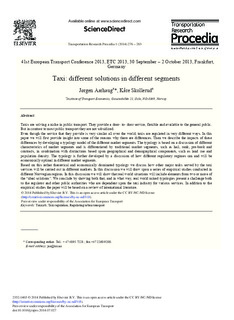| dc.contributor.author | Aarhaug, Jørgen | |
| dc.contributor.author | Skollerud, Kåre H. | |
| dc.coverage.spatial | Norway | nb_NO |
| dc.date.accessioned | 2019-06-27T06:59:03Z | |
| dc.date.available | 2019-06-27T06:59:03Z | |
| dc.date.created | 2015-02-06T11:10:42Z | |
| dc.date.issued | 2014-09-05 | |
| dc.identifier.citation | Transportation Research Procedia. 2014, 1 (1), 276-283. | nb_NO |
| dc.identifier.issn | 2352-1465 | |
| dc.identifier.uri | http://hdl.handle.net/11250/2602429 | |
| dc.description.abstract | Taxis are solving a niche in public transport. They provide a door- to- door service, flexible and available to the general public. But in contrast to most public transport they are not subsidized.
Even though the service that they provide is very similar all over the world, taxis are regulated in very different ways. In this paper we will first provide insight into some of the reasons why there are differences. Then we describe the impacts of these differences by developing a typology model of the different market segments. The typology is based on a discussion of different characteristics of market segments and is differentiated by traditional market segments, such as hail, rank, pre-book and contracts, in combination with distinctions based upon geographical and demographical components, such as land use and population density. The typology is further developed by a discussion of how different regulatory regimes can and will be economically optimal in different market segments.
Based on this rather theoretical and economically dominated typology we discuss how other major tasks served by the taxi services will be carried out in different markets. In this discussion we will draw upon a series of empirical studies conducted in different Norwegian regions. In this discussion we will show that real world situations will include elements from two or more of the “ideal solutions”. We conclude by showing both that, and in what way, real world mixed typologies present a challenge both to the regulator and other public authorities who are dependent upon the taxi industry for various services. In addition to the empirical studies the paper will be based on a review of international literature. | nb_NO |
| dc.language.iso | eng | nb_NO |
| dc.publisher | Elsevier | nb_NO |
| dc.rights | Attribution-NonCommercial-NoDerivatives 4.0 Internasjonal | * |
| dc.rights.uri | http://creativecommons.org/licenses/by-nc-nd/4.0/deed.no | * |
| dc.title | Taxi: Different Solutions in Different Segments | nb_NO |
| dc.title.alternative | Taxi: Different Solutions in Different Segments | nb_NO |
| dc.type | Journal article | nb_NO |
| dc.type | Peer reviewed | nb_NO |
| dc.rights.holder | © 2014 Published by Elsevier B.V. | nb_NO |
| dc.description.version | publishedVersion | nb_NO |
| cristin.unitcode | 7482,0,0,0 | |
| cristin.unitname | Transportøkonomisk institutt | |
| cristin.ispublished | true | |
| cristin.fulltext | original | |
| cristin.qualitycode | 1 | |
| dc.identifier.doi | 10.1016/j.trpro.2014.07.027 | |
| dc.identifier.cristin | 1218011 | |
| dc.source.journal | Transportation Research Procedia | nb_NO |
| dc.source.volume | 1 | nb_NO |
| dc.source.issue | 1 | nb_NO |
| dc.source.pagenumber | 276-283 | nb_NO |

